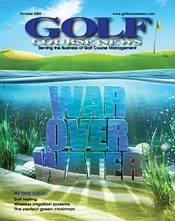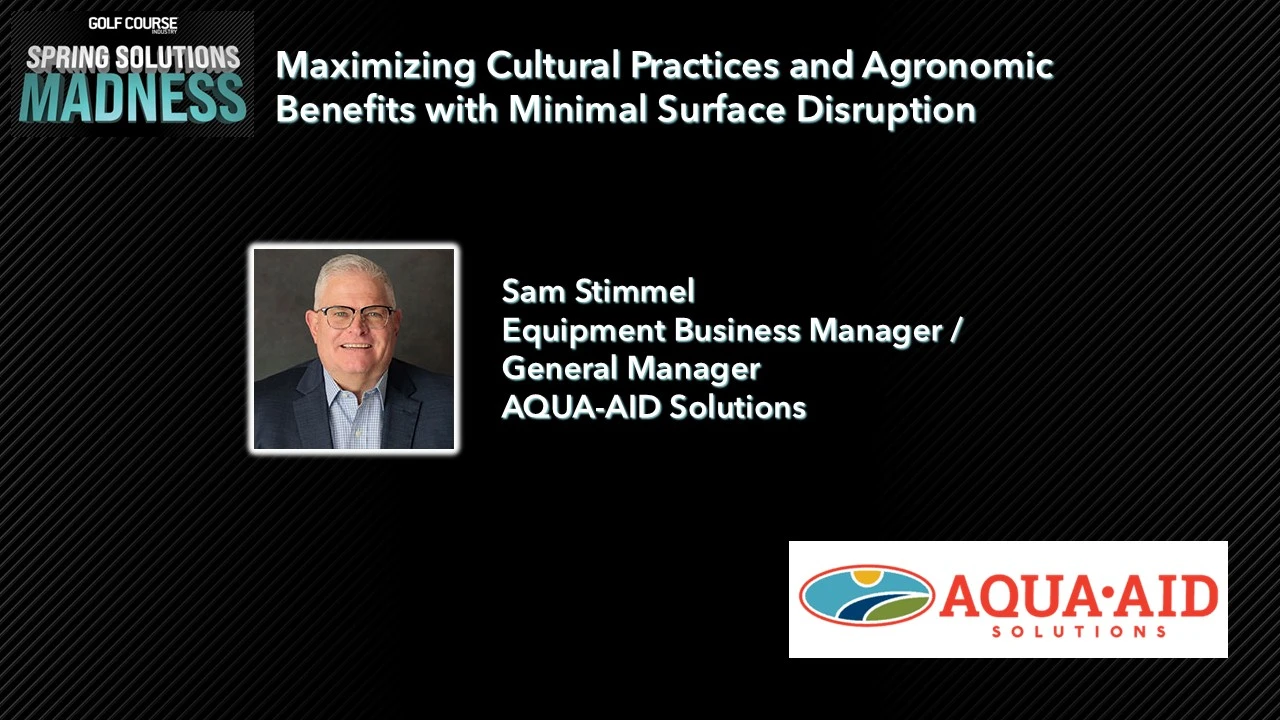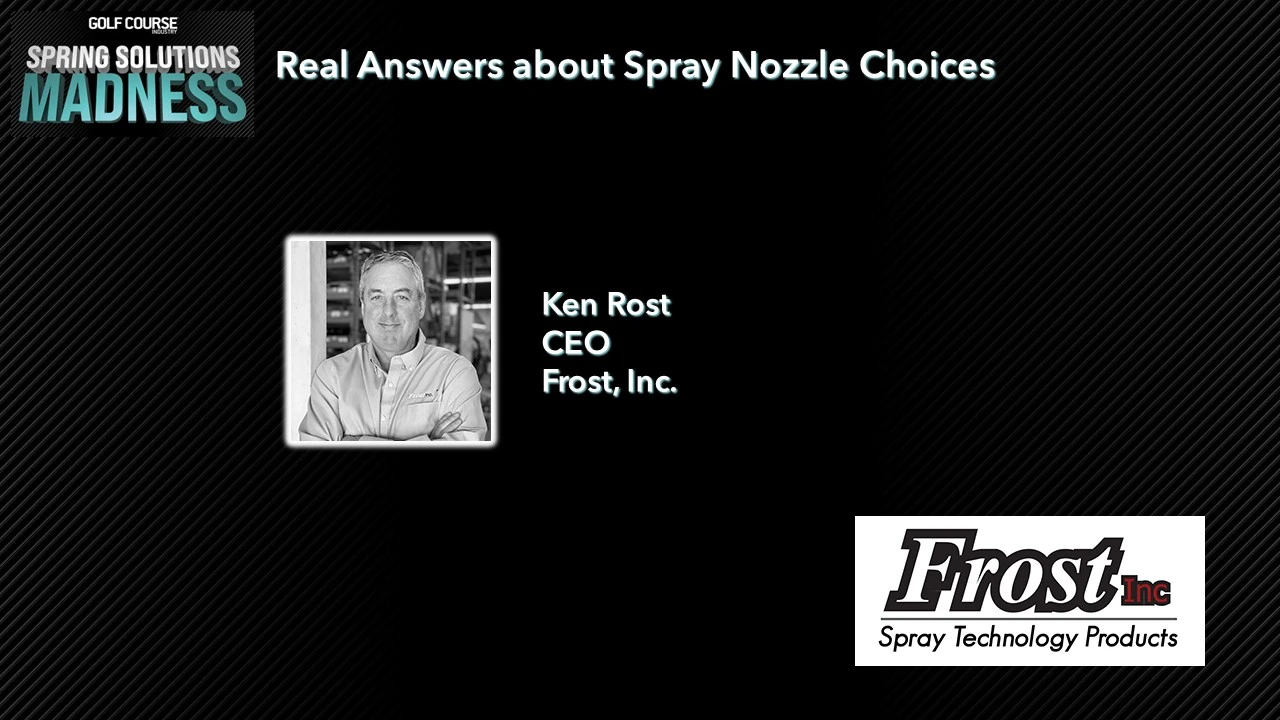Golf Course News interviews David Swift, superintendent of the Straits Course at Whistling Straits Golf Course in Kohler, Wis.
Why was the course selected to host the PGA Championship?
More than anything else, the PGA of America was intrigued with the mystique of the venue. There’s nothing else like it in America. From a logistics standpoint, we held the 1999 Club Professional Championship, which went over quite well, and the PGA of America was excited with the record setting attendance at the CPC. The course seemed to fit well with the galleries, so that is another reason why it looked at Whistling Straits.
How does the selection of the course differ from other tournaments?
The scope of the event. There were millions of people viewing the Championship and as many as 50,000 to 60,000 people a day on the golf course. Being able to move the people around safely was the No. 1 thing we planned for. We built a lot of roads and spectator viewing areas to make it more accessible for people to watch golf.
How far in advance were you notified that you were hosting the PGA Championship? Was it enough time to prepare?
We found out in January of 2000, and preparation started that day. We had just enough time for such a young course.
How old is the course?
We opened in July of 1998, so it’s six years old.
|
|
What is the first and last thing you did to prepare for the tournament?
The first thing we did was move a lot of roads around so we could move spectators through, and get equipment, personnel and vehicles safely on the golf course. Secondly, from the golf course maintenance end of it, we built a few extra tees and bunkers. Then I paid attention to the agronomics and made sure our maintenance programs were in place so we were going to be ready turfwise. We started aerifying the greens aggressively in 2001, 2002 and 2003, so this year, we were prepared. Same with the fairways. With the fine fescue fairways, they thrive in sandy soil, so we started a topdressing program so we could maintain championship conditions.
Did you change your overseeding practices?
We started overseeding fescues. We’ve done it twice in the past 12 months with great success, with a few newer varieties, and they’ve been good so far.
What restrictions were put on golfers during tournament preparation?
There weren’t any restrictions on everyday golfers. We stopped having excessive associate play a year ago to give the golf course a bit of a break, but we didn’t have any special requests of our guests. The last day for public was July 31, so we had nine days to heal up the course from traffic, ball marks and divots. It was just enough time. I know other superintendents that have hosted other championships that don’t get that long – members play right up until tournament starts.
Does it depend on whether it’s a public or private course?
It may have a lot to do with it. We got lucky. Mr. Kohler (president of Kohler Co. and owner of Whistling Straits) and Steve Friedlander, the general manager and director of golf, felt it was important to give the golf course a break and let it heal to be prepared for championship conditions.
What course-design changes did you implement before the tournament?
We narrowed the fairways. We used to have 37 acres of fairways, and we narrowed them down to 21 acres. We changed a lot of fairway contours, the widths, the landing areas. The overall acreage was drastically reduced, almost 60 percent of what we used to have in play.
Did you lengthen the course?
We built three different tees and lengthened the course by about 100 yards, but the weather dictated what tees were used championship week. We simply provided the PGA of America with additional options.
What parts of the course needed to be improved?
Definitely the fairways. The quality of the fairways was slowly improving every year, and we felt we had to be aggressive and stay on the topdressing program. That was probably the slowest part of the improvement. We had to do an awful lot to prepare them, along with the aerification of the greens. The greens hadn’t been neglected, but they hadn’t had the extra attention because of the long construction process, so we wanted to go in there and aggressively tend to the greens to make sure that we could reach championship speeds and have healthy turf going into the championship. I’m really glad we started early on our preparations after hearing some of the players’ compliments that week.
Is there anything you regret doing?
Looking back, no. We gave it 100 percent the whole time. Because with the time frame we had, we did as much as we possibly could. But there’s still more to do. We have the Senior Open in 2007, so we’re going to get back out there.
What additions were made to the maintenance crew?
This year, we brought in 10 associates more than normal. A lot of it had to do with bunker maintenance. The bunkers needed a lot of attention. We have more than 1,000 bunkers on the golf course, so we definitely wanted to make sure we kept up with them this year in case we had any weather and washouts. We also wanted to make sure the drainage was right.
We also recruited a bunch of guys that can work well on a team. That was most important – building a team. We have a great team. I wanted to make sure during the last few years going into this championship we definitely had the right people working on our team.
How many superintendents did you bring in?
Of the 45 volunteers that we had, many of them were superintendents and assistant superintendents.
Explain the brotherhood of other superintendents coming to help you out?
The good thing about the Golf Course Superintendents Association of America is that everyone is willing to help each other out. And the best thing about golf course superintendents is they’re not afraid to share information, share ideas and help each other out along the way. I feel fortunate that I have a lot of superintendent friends in the business that were willing to come and help for a week – giving up a full week of their time to come and help; and not only do whatever is asked of them, but share ideas and input. Hopefully, I get as much out of them as they get out of me.
Everyone was supportive. It was a lot of fun. I had 20 guys who are in the business helping me, and they all knew what to do. We mentioned what we’re going to do each day, and then they went out and did them like they’ve been working here for years. It was great. I trusted them because they knew the expectation level, and they know the business.
What are you responsible for outside of the actual course?
Nothing. Fortunately, for me, I don’t have to worry about anything outside the ropes. So tees, greens, fairways and bunkers, and that’s it. It keeps me focused. With the PGA village going up and all of the construction of the village and everything that went on, I didn’t have to worry about that one bit. I’m fortunate to have Mike Lee, director of golf course maintenance at Kohler’s four area courses, because he’s directly involved with everything going on in the village. He is able to delegate work.
How often does Whistling Straits host tournaments throughout the year?
Not very often. We have resort guests every day of our season, so we haven’t had many tournaments. The only other tournament we’ve hosted is the 1999 Club Professional Championship – that and the championship this year and the 2007 Senior Open.
Do you like it that way or would you like to see more tournaments?
I’d like to see more tournaments, but with the Straits Course, it’s a different atmosphere. Blackwolf Run has the state open every other year, and it has a few other tournaments every now and again. I like how it is right now, preparing for one big tournament and setting a high goal. A week before the tournament, I felt the greatest satisfaction reaching that goal.
Did you receive any feedback from the golfers about the condition of the course throughout the tournament?
Tiger Woods came up the week before the tournament and played the course and he said it was in immaculate condition. Players commented on the greens – the greens were some of the best greens they played on all year. They played true and rolled perfect. Everybody liked it. A lot of them liked the design, which was great.
Hosting the PGA Championship has to be a great boost of confidence for you.
The whole crew was pumped because we had been doing so much work to the golf course the past couple of years, from the aerification to the sand topdressing of the fairways. It finally all panned out. Everybody saw their hard work pay off. All those long days spent doing the same job over and over again. We got the turf conditions to where we wanted them. The crew enjoyed it. They got to sit back and watch 50,000 people watch Tiger Woods play on their product.
How did you feel before and during the tournament?
After attending Oak Hill in Rochester, N.Y., last year and coming back to Whistling Straits, we knew we still had some work to do, and I felt a little bit nervous. But we started planning for the tournament a long time ago. I met with Mike Lee and my assistants weekly. The nervousness went away as we got closer because we spent so much time planning.
About a month before the tournament, it was to the point where there was nothing else we could plan for. We had a meeting one day, and we didn’t have much to talk about. We talked about how we were going to go on vacation after the tournament. We realized we planned and were waiting for everything to happen. The golf course has been brought to a new level and peaked for the tournament.
As the event came closer, the more comfortable I felt. The week of the tournament was quiet around here. We didn’t have one little hiccup. I felt relaxed and didn’t feel stressed out.
Is hosting a tournament like this a resume builder, and what does it do to your ego?
It’s definitely a resume builder. I’m awfully proud to have been a part of the championship, to have worked with such a good crew and to have made the championship the success that it was.
As far as ego, I got a lot of compliments, and every compliment I got I passed on to the crew because I’m only as good as they are. I hope the last thing that gets bigger is my ego. I try to be modest about it because I’m just one of many who prepared this golf course to get it where it is. I’m not talking about just the maintenance staff, I’m talking about the guys who built it. When I first came here six year ago, the guys that built the course were still here, and I worked with those guys. I worked for Mr. Dye. They’re amazing. Those guys have such an eye for detail, and they are good at what they do. And all the maintenance guys that have been here since, including the guys I have here now. There are hundreds of people. I couldn’t begin to name them all.
What did you learn during the tournament?
I’ve learned that the more preparation you have in the beginning, the better off you’ll be. We tried to plan for every little thing that could go wrong. Everything went smooth because of all the preparation we did. The best part about it was seeing all the people who worked with us, especially the guys in the crew, rise to the event. The guys stepped it up and took pride in their work, and that’s the most fun to me.
The most satisfying part is seeing everybody work together. You have 140 people on the golf course for two hours in the morning, and every person is working for the same thing: they are trying to make the golf course as good as it can possibly be. The attention to detail these people have is unbelievable.
Is there such thing as perfection on a golf course?
The problem we have in this business is that things are never perfect. That’s why we work 80-, 90-, 100-hour weeks, because the course is never where we want it to be. We try to manage a constantly changing environment, and if it’s perfect, it’s just a moment in time. Are we perfect, no. But we are as good as we can be. We’ve gave it 100 percent. We have nothing to be ashamed of.
Where would you go next in your career?
Everybody has a lot of goals, but with everything that is going on here at Kohler, I don’t plan on leaving. We’ve got the Senior Open in 2007. That’s another great opportunity to host another major tournament. I have it good here. I have a good crew, and I work for a good company on a beautiful golf course.
Were there any turfgrass problems or diseases that you dealt with that troubled or concerned you?
We had a wet spring. We had about 17 inches of rain in 35 days. We lost a little bit of grass because of the wetness, and fescues don’t like being in real wet soil. But that’s typical, and we understand how that goes and did everything necessary to bring the turf back.
Were there any changes or additions to the equipment?
We had great help from the people at Jacobsen. We use LF 1880s, a lightweight, triplex fairway mower with 18-inch reels. They supported us by bringing eight extra machines. We have four machines that we lease, and we had eight of their machines. They also brought us 22 greens mowers to use during the tournament, and they had their best mechanics here. They made a lot of promises and came through on every single promise. They wanted this as bad as we did. They wanted the tournament to be a success.
Were there any other challenges or problems you dealt with?
The weather. A year ago, we had a cold spring. This year we had a warm spring. With a warm spring, we had a lot of rain. It was frustrating because we had so much rain in a short period of time, and we couldn’t do much. We were struggling just to get the turf mowed. Other than that, the weather was pretty good.
What is your relationship with the PGA during tournament prep?
The PGA sends its senior director of tournaments, Kerry Haigh. He met with us several times a year. He came out, and we walked the golf course – myself and Mike Lee and Steve Friedlander. We went over every little detail and made sure everything was in line with what came up.
What are some things you look at?
Definitely the mowing heights for the fairways and the roughs. We paid close attention to the mowing lines and what we needed to do to them to make it look and play like it did during the tournament. We had to work out a lot of bugs. When were we going to mow? What were we going to mow with? What height works, according to what Mr. Haigh wanted.
Are those heights shorter than what you typically cut?
They are little bit longer than what we typically have. For normal play, we cut our rough at about 3 inches. For the PGA, they were 4 to 6 inches, so was a little taller and a little thicker.
Are you doing anything to the course now or are you going to leave it exactly the way it is?
That’s up to the United States Golf Association and Kohler Co. The USGA will be coming in next year to start preparing for the 2007 Senior Open, so I don’t know what’s going to happen until then. We’re going to go out and seed a lot of the areas of the rough that are getting trampled. We put a lot of seed in places where we don’t think the grass is going to come back. The gallery trampled in the seed, so it got good seed to soil contact. Now that the tournament is over, we’ll get germination of the seed, and the grass will come right back up.
What advice would you give to other superintendents who will prepare for a tournament of this magnitude?
Start your preparation early. Get all your planning done, as much as you can as early as you can, and fine tune every little detail because the sooner you have that stuff done, the easier you’ll sleep at night. I felt under a lot of pressure during the initial planning stages. There’s a lot to think about and a lot to plan for. The more plans that we had in place and the more decisions we made early on, the easier it was to move on to the next decision. It was also easier to find out where we made mistakes in our planning and what you had to change. The earlier one starts, the easier it is along the way.
Anything else?
Another important thing is building the right team of associates. We have a lot of young guys that work their butts off, and they should be proud. It doesn’t matter if I get a compliment or Mike Lee gets a compliment. Those are the guys that are doing all of the work. Those are the guys that are here every morning at 5 a.m. ready to go and stay as late as we ask them to.
I’m glad I built the team I did leading up to the championship because I don’t know where I would be without half these guys. Some of the things these guys have done and the way they’ve done it was amazing. All the guys worked hard to get the golf course the way it is. It’s in outstanding condition, and we’re proud. I’m more proud that I brought these guys here. I got them here because they’re the ones that made us all shine. GCN
David Swift can be reached at david.swift@kohler.com.
Get curated news on YOUR industry.
Enter your email to receive our newsletters.
Explore the October 2004 Issue
Check out more from this issue and find your next story to read.
Latest from Golf Course Industry
- Tartan Talks 105: Nathan Crace and Todd Quitno
- Disease Discussion 24: Let the turf talk to you
- From the publisher’s pen: Foggy intrigue
- USGA releases Water Conservation Playbook
- Vilamoura Golf courses awarded GEO Certified status
- GCSAA’s Health in Action 5K/2K reaches fundraising goal
- Landscapes Golf Management to participate in data analyzation initiative
- Reel Turf Techs: Carl Michael







